1/1/2021
Debunking Myths About Spotted Lanternfly
JC Chong
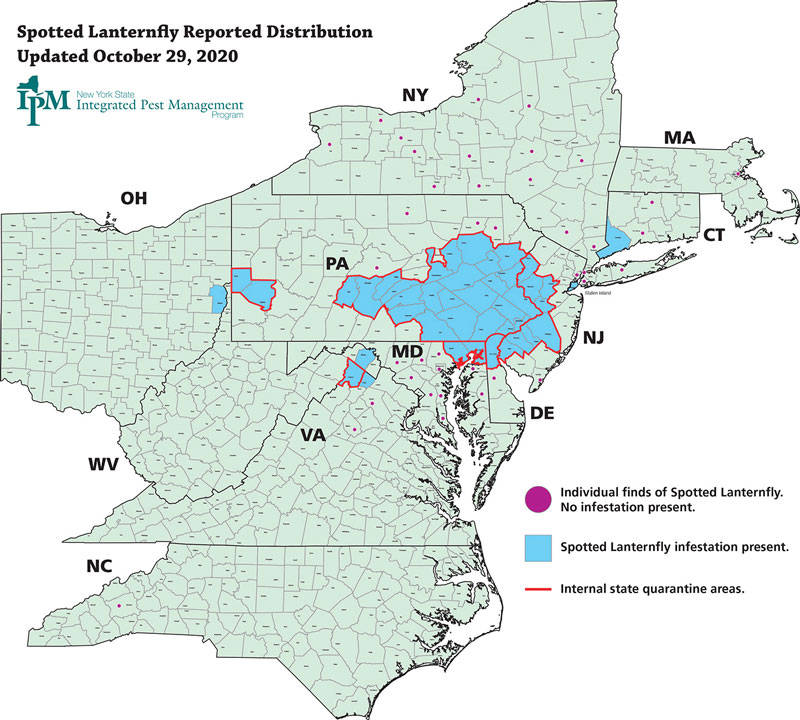
Spotted Lanternfly is spreading throughout the country and they feed on everything! And they’re destroying agriculture in the United States! The bugs are aliens and only napalm can kill them! Or are they?
Spotted Lanternfly (SLF) has generated many attention-grabbing headlines and “a lot of hype,” said Brian Walsh, Pennsylvania State University (PSU) Extension Horticulture Educator at Berks County, Pennsylvania. Berks County became Ground Zero of the SLF invasion in 2014 and Brian has had a front row seat to all the commotion and drama.
Figure 1. Reported distribution and sightings of Spotted Lanternfly in the Eastern United States. Source: NY IPM Program.
Brian was calm and composed as he shared some of his observations and research data, and debunked one myth (or outdated information) after another during a webinar titled “Spotted Lanternfly: Impacts and Strategies for Ornamental Plants” on November 17. The webinar was hosted by the Horticultural Research Institute as part of its tHRIve web series.
Here’s a sample of myths and truths about SLF:
Myth #1: SLF will cost Pennsylvanian agriculture $18 billion annually.
Truth: Brian only commented that the economic impact of SLF isn’t anywhere near that. This myth is perhaps best described as an outdated estimate often quoted by officials and media. A recent analysis by Jayson Harper, professor of agricultural economics at PSU, and his colleagues provided revised dollar figures.
In the quarantine zone in southeastern Pennsylvania, the overall direct, indirect and induced economic impacts of SLF is estimated to be $50.1 million per year with a loss of 484 jobs. If SLF spread across Pennsylvania, the expected losses increase to $324.9 million annually with a loss of 2,810 jobs. In the worst-case scenario, statewide annual damage in Pennsylvania is estimated at $554 million and a loss of almost 5,000 jobs. Forestry, fruits (particularly grapes), nurseries and Christmas trees are the agricultural commodities most significantly impacted. The estimated direct economic impact (i.e., loss of revenue and crops) to Pennsylvanian agriculture is $13.1 million in the quarantine zone and $42.6 million statewide.
Myth #2: SLF has spread throughout the United States.
Truth: There are several recent news reports of finding egg masses or dead adults from Maine to California. These reports remind us that SLF has an amazing potential to spread, but they shouldn’t be taken as evidence of establishment.
Brian shared the most recent distribution of SLF (Figure 1), produced by the New York State IPM Program, showing that established infestations are detected in potions of Connecticut, Delaware, Maryland, New Jersey, Ohio, Virginia and West Virginia that are bordering Pennsylvania. Multiple individual finds of adults and egg masses were reported in Massachusetts, New York and North Carolina, but these aren’t established populations. Folks outside of the confirmed established areas should stay vigilant, but not panic.
Growers within the established range should check with their states’ and the receiving states’ regulatory agencies about phytosanitary or quarantine regulations concerning SLF. Quarantine is currently imposed on counties in Delaware, Maryland, New Jersey, Pennsylvania and Virginia. Compliance to quarantine regulations is critical to slowing down the spread of SLF.
Where can we expect the next SLF hot spots? Only time will tell. Using a climatic matching model, called Maxent, scientists at the USDA Agricultural Research Service recently published a map of potential SLF habitat (Figure 2). The highest risk areas include New England, the Mid-Atlantic, the Midwest, Central Valley and coastal regions of California, and the Columbia Valley region of the Pacific Northwest. It isn’t to say that infestation cannot establish in areas that are rated as moderate or low risk. Everyone should stay vigilant and report sightings.
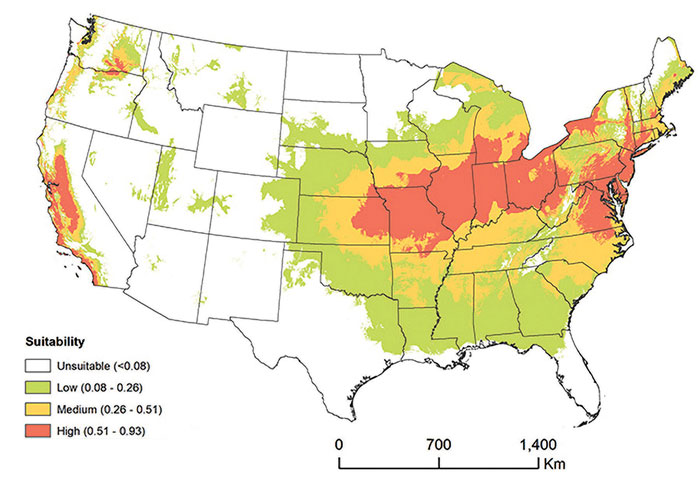 Figure 2. Estimated suitability for Spotted Lanternfly establishment.
Figure 2. Estimated suitability for Spotted Lanternfly establishment.
Source: Wakie et al. 2019, Journal of Economic Entomology 113: 306-314.
SLF is very easy to identify. Adults begin to appear at the end of July in Pennsylvania. They’re about 1-in. long (males are slightly smaller) with a pair of gray front wings sporting multiple black spots and a pair of red and black hind wings (Figure 3). They lay 30 to 50 eggs in an egg mass glued to the tree. The waxy material covering the eggs turns from white to dark gray quickly and likely provides protection from predators and winter temperatures. The eggs overwinter and hatch in the spring, typically in May. First- to third-instar nymphs are black with white spots. The red-and-black and white-spotted fourth-instar nymphs (Figure 4) appear in July.
Myth #3: SLF only walk and hop.
Truth: They do, but adults can also fly! After all, SLF is a species of treehopper, with strong hind legs for hopping and well-developed wings for flying. SLF adults aren’t strong enough to take off from rest like a dragonfly or fly a long distance like a Monarch butterfly. But they can climb to the top of a tree, catch the wind and fly a short distance.
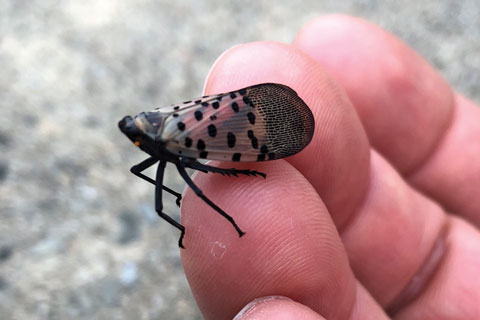 Figure 3. Adult Spotted Lanternfly. Photo credit: David Coyle, Clemson University.
Figure 3. Adult Spotted Lanternfly. Photo credit: David Coyle, Clemson University.
Nymphs are always on the move, walking and hopping between host plants. A team of researchers led by Kelli Hoover, professor of entomology at PSU, documented an average dispersal distance of 6.1 m. (20 ft.) in one day or 19.2 m. (63 ft.) over seven days. The longest distance the team had observed was 65 m. (213 ft.) in 10 days.
It’s clear from the current distribution that long-distance spread of SLF was accomplished by hitchhiking on commodities and goods, which were subsequently moved out of the established areas through a transportation network. SLF females lay their distinctive egg masses on trees and other objects.
These egg masses, which are flat and gray, are extremely difficult to detect on conifers, noted Brian. This presents a particularly challenging problem for ornamental and Christmas tree growers, who have to spend a significant amount of time and resources to prevent adults from laying eggs, to find the egg masses and to remove trees from shipment or make insecticide applications when eggs are found.
Myth #4: SLF is a tree killer.
Truth: SLF rarely kills trees, except for trees that are small and stressed. SLF is best characterized as a tree health stressor.
SLF, like its other treehopper cousins, feeds through piercing-sucking mouthparts. Removal of a large amount of tree sap can stunt growth and reduce vigor of the affected trees. One of the most oft-cited problems associated with SLF infestation is the large amounts of honeydew and sooty mold landing on and staining all manners of living and inanimate objects (Figure 5). Sooty mold can further reduce plant growth and health by covering the leaves and reducing photosynthesis. Not only are they annoying, honeydew can also attract other insects, some of them potentially dangerous, such as bees and wasps.
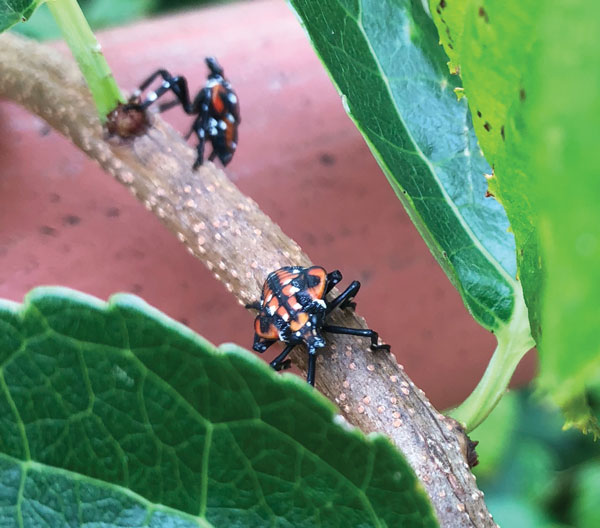 Figure 4. Fourth-instar Spotted Lanternfly. Photo credit: David Coyle, Clemson University.
Figure 4. Fourth-instar Spotted Lanternfly. Photo credit: David Coyle, Clemson University.
Researchers at PSU are working on understanding how feeding by SLF can impact plant growth and physiology. Preliminary results seem to indicate tree species respond differently to SLF feeding through changes in photosynthesis, gas exchange and glucose concentration. Results will be published in the near future and will give us a clearer picture of how SLF impacts tree health.
Myth #5: Tree of heaven is essential to SLF development.
Truth: Recent studies suggested that fecundity increased and nymphs developed faster when feeding on tree of heaven. However, survival of SLF without access to tree of heaven was similar to those that had the opportunity to feed on them. These results indicate that tree of heaven is a preferred host, but it isn’t necessary for the survival of the population. This result has a significant implication, said Brian—eliminating tree of heaven from an area isn’t likely to reduce SLF population or stop its spread and establishment.
There’s still much to learn about SLF host selection behavior. SLF can feed on the tender shoots of many plant species during the first to third instar, but appear to prefer tree of heaven and black walnut at the fourth instar. Adults can lay eggs on many tree species and objects, but seem to prefer red and sugar maples, reported Brian.
What makes a “hot” tree? Based on observation that senesced trees are often not attacked, Brian believes a “hot” tree is perhaps one that’s most healthy and vigorous, with the best sap flow.
Myth #6: “Trap trees” are a great way to manage SLF.
Truth: Tree of heaven is a magnet for SLF, which makes this species a good choice for a “trap tree.” Various types of intercept traps can be installed on the trees to capture SLF, or the trees can be injected or drenched with a systemic insecticide, such as dinotefuran. When SLF feed on these treated trees, they ingest the toxin and die in huge numbers.
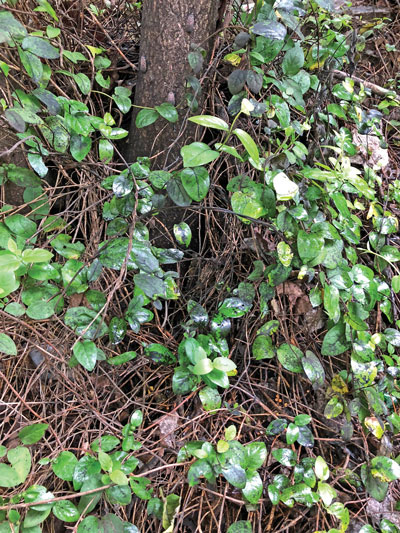 At first glance, trapping or treating tree of heaven seems to be a very effective way of killing SLF. However, killing thousands of SLF is only removing one drop from an ocean. Trapping or treating one or a handful of tree of heaven will have minimal impact on the SLF population and impacts.
At first glance, trapping or treating tree of heaven seems to be a very effective way of killing SLF. However, killing thousands of SLF is only removing one drop from an ocean. Trapping or treating one or a handful of tree of heaven will have minimal impact on the SLF population and impacts.
Myth #7: Egg scalping is a great way to reduce SLF population.
Truth: SLF females don’t deposit egg masses haphazardly on anything; they prefer tree bark or objects that are sheltered. More than 75% of the egg masses are found at 9 m. (29.5 ft.) or higher; too high for anyone to reach and scrub successfully. So egg scalping isn’t likely to be an effective management approach. Insecticide application against egg masses is also not likely to be effective because of the difficulty of spraying at great height (and consider the risk of insecticide drift!) and penetrating through the waxy materials covering the egg masses.
Figure 5. Spotted Lanternfly infestation is often associated with a large amount of honeydew and sooty mold. Photo credit: David Coyle, Clemson University.
We’ll continue to talk about SLF in years to come. Brian’s webinar has debunked several myths and updated several pieces of outdated information. As research on SLF continues, we’ll learn more about this pest, and better ways to manage its population and impacts. More research updates will be provided in the future.
In the meantime, check out the SLF website by PSU Extension (extension.psu.edu/spotted-lanternfly) for the most up-to-date information and management guidelines. GT
Juang-Horng “JC” Chong is a professor and extension specialist at Clemson University, and editor of the PestTalks e-newsletter.